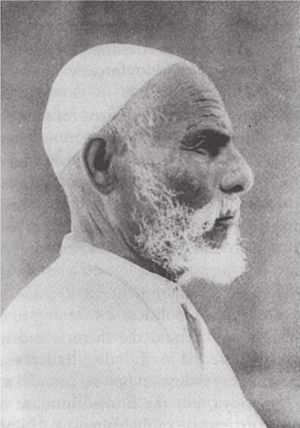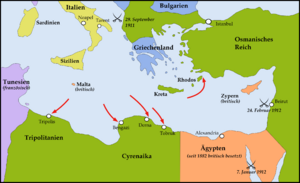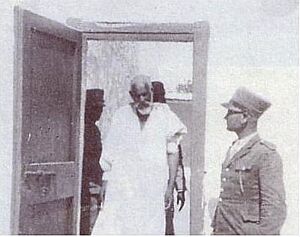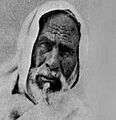Omar al-Mukhtar facts for kids
Quick facts for kids
Omar al-Mukhtar
عُمَر الْمُخْتَار |
|
|---|---|

Assad El-Sahra (أسد الصحراء) or "Lion of the Desert"
|
|
| Ruler of Zawiyat Ayn Kalk | |
| In office 1896–1902 |
|
| Succeeded by | Post abolished |
| Ruler of Zawiyat Luqsur | |
| In office 1902–1911 |
|
| Succeeded by | Post abolished |
| Leader of Senussi Tribal Military | |
| In office 24 April 1923 – 16 September 1931 |
|
| Preceded by | Idris Al-Senussi |
| Succeeded by | Yusuf Borahil |
| Personal details | |
| Born | 20 August 1858 Benghazi, Eyalet of Tripolitania, Ottoman Empire |
| Died | 16 September 1931 (aged 73) Soluch concentration camp, Benghazi, Italian Cyrenaica |
| Resting place | Suluq |
| Nationality | Ottoman, Libyan |
| Children | Muhammad |
| Parents |
Al-Mukhtar ibn Muhammad (father)
Aisha bint Muharib (mother) |
| Occupation | Ruler of Senussi Zawiyas |
| Known for | Leading Arab native resistance to Italian colonization of Ottoman Tripolitania |
| Religion | Sunni Islam |
| Signature |  |
| Nicknames | Shaykh ash-Shuhadā' شَيخ الشُّهَدَاء, Sheikh of the Martyrs |
| Military service | |
| Allegiance | |
| Branch/service | |
| Years of service | |
| Battles/wars | Italo-Turkish War Senussi campaign Senussid-Italian War |
Omar al-Mukhtar (born August 20, 1858 – died September 16, 1931) was a famous Libyan leader. He was known as The Lion of the Desert. Omar al-Mukhtar led the fight against the Italian invasion of Libya.
He was a teacher who became a military leader. Omar al-Mukhtar is seen as a national hero in Libya. He is also a symbol of resistance in the Arab and Islamic worlds. He fought against the Italian army from 1911 until his capture in 1931. He also fought against French and British forces in nearby regions. The Italian army captured him after he was wounded. He was executed in 1931 because he refused to give up.
Contents
Early Life and Education
Omar Al-Mukhtar was born in 1858 in a town called Zanzur, near Tobruk, in what was then Ottoman Cyrenaica. He belonged to the Mnifi tribe. When he was young, Omar lost his father and grew up in poverty. A religious leader, a sheikh, adopted him.
He received his early education at a local mosque. Later, he studied for eight years at the Senussi University in Jaghbub. This was a holy city for the Senussi religious group. He became an expert on the Quran, the holy book of Islam. He also became an imam, a Muslim prayer leader. He was good at solving problems between different tribes.
Omar Mukhtar became very close to the Senussi Movement. In 1895, he traveled south with Al-Mahdi Senoussi to Kufra and then to Karo in Chad. There, he became the leader of a religious center called Zawiyat Ayn Kalk. When the French Empire moved into Chad in 1899, Omar was sent to help defend the area. The Senussi group saw the French expansion as a danger because of their missionary work. In 1902, Omar was called back north. The new Senussi leader, Ahmed Sharif as-Senussi, made him the leader of Zawiyat Laqsur in Northern Cyrenaica.
Italian Invasion of Libya
In October 1911, Italy started a war with the Ottoman Empire. This war was called the Italo-Turkish War. The Italian Royal Navy arrived at the shores of Libya. Libya was under Ottoman control at that time. The Italian admiral demanded that the Ottoman army surrender. If they didn't, the cities of Tripoli and Benghazi would be destroyed.
The Ottomans and their Libyan allies did not surrender. Instead, they moved their forces away from the cities. The Italians then bombed the cities for three days. After that, they announced that the people of Tripoli were now part of Italy. This event started many battles between the Italian forces and the Libyan resistance.
Leading the Resistance
Omar Mukhtar was a teacher of the Quran. But he was also very skilled in guerrilla warfare tactics. He knew the desert geography very well. He used this knowledge to his advantage against the Italians. The Italian soldiers were not used to fighting in the desert.
Mukhtar led small, fast groups of fighters. They would attack the Italians successfully and then quickly disappear back into the desert. His men attacked Italian outposts, ambushed troops, and cut off their supply lines. The Italian army was surprised and frustrated by his tactics.
In 1924, the Italian governor created a special force to fight the guerrillas. This force caused some problems for Mukhtar's fighters. But Mukhtar quickly changed his tactics. He also continued to receive help from Egypt. In 1927, Mukhtar surprised Italian troops at Raheiba. Between 1927 and 1928, he reorganized his forces. They were constantly being hunted by the Italians. Even the Italian general recognized Omar's "exceptional perseverance and strong willpower."
In 1929, the Governor of Libya, Marshal Pietro Badoglio, tried to make a deal with Mukhtar. But Mukhtar refused the deal and continued to fight. In 1930, General Rodolfo Graziani became the Italian military commander. He launched a big attack against Mukhtar's forces, but it failed.
Graziani then started a harsh plan to defeat the Libyan resistance. He ordered 100,000 people from the Jebel Akhdar region to be moved to concentration camps on the coast. He also built a fence along the Libyan-Egyptian border. This was to stop any help from reaching the fighters. These actions made it very hard for the resistance. The rebels lost their support and supplies. They were spied on and attacked by Italian planes. Italian forces, helped by local informers, pursued them on the ground.
Despite these difficulties, Mukhtar continued his struggle. On September 11, 1931, he was ambushed near Slonta.
Capture and Execution
Omar Mukhtar's fight of almost twenty years ended on September 11, 1931. He was wounded in battle near Slonta. Then, he was captured by Libyan soldiers who were part of the Italian army.
On September 16, 1931, Omar Mukhtar was executed. He was 73 years old. The execution happened in front of his followers at the Soluch concentration camp. The Italians hoped that his death would end the Libyan resistance.
Legacy
Omar al-Mukhtar remains a very important figure in Libya and beyond.
- Omar Al-Mukhtar University was founded in 1961.
- Since 1971, Mukhtar's face has been on the Libyan ten-dinar banknote.
- His life story was shown in the 1981 movie Lion of the Desert. The movie starred Anthony Quinn.
- A famous quote from Omar, popularized by the movie, is: "We are people that will not surrender, we win or we die."
- In 2009, Libyan leader Muammar Gaddafi wore a photo of Mukhtar during a visit to Rome. He also brought Mukhtar's elderly son with him.
- During the 2011 Libyan Civil War, Omar Mukhtar became a symbol for a united and free Libya. His picture appeared on many flags and posters of the anti-Gaddafi forces.
- A school in Irbid, Jordan, is named after Mukhtar.
- A mosque in Tampa, Florida, USA, is named Masjid Omar Al Mokhtar.
- Streets are named after Mukhtar in many cities, including:
- Kuwait City, Kuwait
- Gaza City
- Cairo, Egypt
- Doha, Qatar
- Bizerte, Tunisia
- Riyadh, Saudi Arabia
- Irbid, Jordan
- Tangier, Morocco
Images for kids
See also
- Omar the North African lion
- Senussi
- We Will Not Surrender (We Win or We Die), protest song during the 2011 Libyan Civil War based on one of Mukhtar's speeches.










